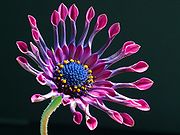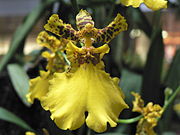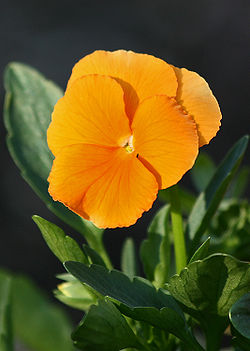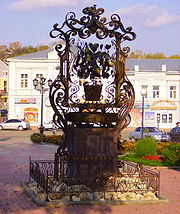
Cultivar
Did you know...
SOS Children made this Wikipedia selection alongside other schools resources. Click here to find out about child sponsorship.
A cultivar is a cultivated plant that has been selected and given a unique name because it has desirable characteristics (decorative or useful) that distinguish it from otherwise similar plants of the same species. When propagated it retains those characteristics.
The naming of a cultivar should conform to the International Code of Nomenclature for Cultivated Plants (the ICNCP, commonly known as the "Cultivated Plant Code"). For this, it must be distinct from other cultivars and it must be possible to propagate it reliably, in the manner prescribed for that particular cultivar.
The word cultivar, coined by Liberty Hyde Bailey, is generally regarded as a portmanteau of "cultivated" and "variety", but could also be derived from "cultigen" "variety". The word cultivar is not interchangeable with the botanical rank of variety, nor with the legal term " plant variety".. Cultivars are a sub-set of Bailey's broader grouping the cultigen, defined as "a plant that has been deliberately altered or selected by humans" (see cultigen for Bailey's original definition of the cultivar, his definitions of the cultigen, and discussion of the current definition of cultigen).
Definition
Article 2.1 of the International Code of Nomenclature for Cultivated Plants states that a cultivar is the "primary category of cultivated plants whose nomenclature is governed by this Code." and defines a cultivar as "an assemblage of plants that has been selected for a particular attribute or combination of attributes, and that is clearly distinct, uniform and stable in its characteristics and that, when propagated by appropriate means, retains those characteristics" (Art. 2.2).
The status of a cultivar is quite limited, with nomenclatural consequences only; it offers no legal protection.
Nature of a cultivar
A cultivar is a particular variety of a plant species or hybrid that is being cultivated and/or is recognised as a cultivar under the ICNCP. The concept of cultivar is driven by pragmatism, and serves the practical needs of horticulture, agriculture, forestry, etc.
The plant chosen as a cultivar may have been bred deliberately, selected from plants in cultivation, or discovered in the wild. Cultivars can be asexual clones or seed-raised. Clones are genetically identical and will appear so when grown under the same conditions. Seed-raised cultivars can be mixes that show a wide variation in one or more traits such as a mix of flower colors, or highly homogeneous plant strains produced by heavily selecting out undesirable traits thus producing a breeding line that is uniform or they can be F1 hybrids produced by cross breeding. There are a few F2 hybrid seed cultivars too (Achillea 'Summer Berries'.)
There is not necessarily a relationship between any cultivar and any particular genome. The ICNCP emphasizes that different cultivated plants may be accepted as different cultivars, even if they have the same genome, while cultivated plants with different genomes may be a single cultivar. In some cultivars, the human involvement was limited to making a selection among plants growing in the wild (whether by collecting growing tissue to propagate from or by gathering seed).
Other cultivars are strictly artificial: the plants must be made anew every time, as in the case of an F1 hybrid between two plant lines. It is not required that a cultivar can reproduce itself. The "appropriate means of propagation" vary from cultivar to cultivar. This may range from propagation by seed which was the result of natural pollination to laboratory propagation. Many cultivars are clones and are propagated by cuttings, grafting, etc.
Cultivars include many garden and food crops: ' Granny Smith' and ' Red Delicious' are cultivars of apples propagated by cuttings or grafting, 'Red Sails' and 'Great Lakes' are lettuce cultivars propagated by seeds. Named Hosta and Hemerocallis plants are cultivars produced by micro propagation or division.
Cultivar names
Cultivars are identified by uniquely distinguishing names. Names of cultivars are regulated by the International Code of Nomenclature for Cultivated Plants, are registered with an International Cultivar Registration Authority (ICRA) and conform to the rules of the ISHS (International Society for Horticultural Science) Commission for Nomenclature and Cultivar Registration. There are separate registration authorities for different plant-groups. In addition, cultivars may get a trademark name, protected by law (see Trade Designations and "Selling Names", below).
A cultivar name consists of a botanical name (of a genus, species, infraspecific taxon, interspecific hybrid or intergeneric hybrid) followed by a cultivar epithet. The cultivar epithet is capitalised and put between single quotes: preferably it should not be italicized. Cultivar epithets published before 1 January 1959 were often given a Latin form and can be readily confused with the specific epithets in botanical names: after that date, newly coined cultivar epithets must be in a modern vernacular language to distinguish them from botanical epithets.
- Cryptomeria japonica 'Elegans'
- Chamaecyparis lawsoniana 'Aureomarginata' (pre-1959 name, Latin in form)
- Chamaecyparis lawsoniana 'Golden Wonder' (post-1959 name, English language)
- Pinus densiflora 'Akebono' (post-1959 name, Japanese language)
- Some incorrect examples:
- Cryptomeria japonica "Elegans" (double quotes are unacceptable)
- Berberis thunbergii cv. 'Crimson Pygmy' (this once-common usage is now unacceptable, as it is no longer correct to use "cv." in this context; Berberis thunbergii 'Crimson Pygmy' is correct)
- Rosa cv. 'Peace' (this is now incorrect for two reasons: firstly, the use of "cv."; secondly, "Peace" is a trade designation or "selling name" for the cultivar R. 'Madame A. Meilland' and should therefore be printed in a different typeface from the rest of the name, without any quote marks, for example: Rosa Peace.)
Where several very similar cultivars exist, these are termed Cultivar Groups; the name is in normal type and capitalised as in a single cultivar, but not in single quotes, and followed by "Group" (or its equivalent in other languages)
- Brassica oleracea Capitata Group (the group of cultivars including all typical cabbages)
- Brassica oleracea Botrytis Group (the group of cultivars including all typical cauliflowers)
- Hydrangea macrophylla Groupe Hortensis (in French) = Hydrangea macrophylla Hortensia Group (in English)
Where cited with a cultivar name the Cultivar Group should be enclosed in parentheses, as follows:
- Hydrangea macrophylla (Hortensia Group) 'Ayesha'
Some cultivars and Cultivar Groups are so well "fixed" or established that they "come true from seed", meaning that the plants from a seed sowing (rather than vegetatively propagated) will show very little variation. In the past, such plants were often called by the terms "variety", "selection" or "strain"; these terms (particularly "variety", which has a very different botanical meaning – see below) are best avoided with cultivated plants. Normally, however, plants grown from seed taken from a cultivar can be very variable and such seeds or seedling plants should never be labelled with, or sold under, the parent cultivar's name (See an article by Tony Lord of The RHS Plant Finder).
Trade designations and "selling names"
Cultivars that are still being developed and not yet ready for release to retail sale are often coded with letters and/or numbers before being assigned a name. It is common for this code name to be quoted alongside the new cultivar name or trade designation when the plant is made available commercially (for example Rosa Fascination = 'Poulmax') and this may continue, in books or magazines and on plant labels, for several years after the plant was released. Because a name that is attractive in one language may have less appeal in another country, a plant may be given different selling names from country to country. Quoting the code allows the correct identification of cultivars around the world and helps to avoid the once-common situation where the same plant might, confusingly, be sold under several different names in one country, having been imported under different aliases.
Another form of what the Cultivated Plant Code (ICNCP) calls a trade designation is the plant "variety", as defined in the UPOV Convention. Not to be confused with the botanical rank of variety.
Cultivars in the garden and natural world
Some cultivars are "naturalized" in gardening, in other words they are planted out and largely left to their own devices. With pollination and regrowth from seed, true natural processes, the distinct cultivars will disappear over time. The cultivar's genetic material however may become part of the gene pool of a population, where it will be largely but not completely swamped. Cultivars that are propagated by asexual means such as dividing, cuttings or micropropagation generally do not come true from seed. Plants raised from seed saved from these plants should never be called by the cultivar name. Seeds collected from seed raised cultivars may or may not come true from collected seeds that are sown. Cross pollination with other plants in the garden or from the surrounding area could occur that could contaminate the seed line and produce different plants the next generation. Even if a seed raised cultivar is grown in isolation, often the cultivar can change as different combinations of recessive genes are expressed, so good breeders maintain the seed lines by weeding out atypical plants before they can pass on their genes or pathogens to the next generation and affect the cultivar line.
Legal points
The practice of patent protection (legally protecting) is an important tool to encourage the development of new useful cultivars; "protected cultivars" are the result of deliberate breeding programs and selection activity by nurseries and plant breeders, and are often the result of years of work. "Plant patents" and "plant breeder's rights" (which can be expensive to obtain) are means for the breeder or inventor to obtain financial reward for their work.
With plants produced by genetic engineering becoming more widely used, the companies producing these plants (or plants produced by traditional means) often claim a patent on their product. Plants so controlled retain certain rights that accrue not to the grower, but to the firm or agency that engineered the variety.
Some plants are often labeled "PBR", which stands for " plant breeders' rights", or "PVR", which stands for "plant variety rights." It is illegal in countries that obey international law to harvest seeds from a patented "variety" except for personal use. Other means of legal protection include the use of trade marked names whereby the name the plant is sold under is trademarked, but the plant itself not protected. Trademarking a name is inexpensive and requires less work, while patents can take a few years to be granted and have a greater expense. Some previously named cultivars have been renamed and sold under trademarked names.
In horticulture, plants that are patented or trade marked are often licensed to large wholesalers that multiply and distribute the plants to retail sellers. The wholesalers pay a fee to the patent or trade mark holders for each plant sold, those plants that are patented are labeled with "It's unlawful to propagate this plant" or a similar phrase. Typically the license agreement specifies that a plant must be sold with a tag thus marketed to help ensure that unlawfully produced plants are not sold. The use of plant patents is considered unethical by some people.





